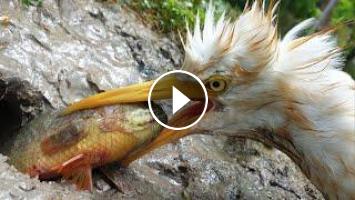Hello my Dear Viewers, Welcome To My Channel Fisherman Animal Lover | Most Interesting And Unique Fishing or Animal Video Updates Every Time |
How Finding and Catching Koi Or Kai Fish or Climbing Perch on Fish Hole The Big White Egret | Best Egret Hunting Video For Their Survived |
Its Amazing Fact of Nature, Every Animal Hunting Process Different and Unique |Best Egret Bird Hunting Video On YouTube 2020|
Intelligent Cattle Egret Bird Hunting Small Fish| Unique And Beautiful Survival Style In Jungle |
The cattle egret (Bubulcus ibis) is a cosmopolitan species of heron (family Ardeidae) found in the tropics, subtropics, and warm-temperate zones. It is the only member of the monotypic genus Bubulcus, although some authorities regard two of its subspecies as full species, the western cattle egret and the eastern cattle egret. Despite the similarities in plumage to the egrets of the genus Egretta, it is more closely related to the herons of Ardea. Originally native to parts of Asia, Africa, and Europe, it has undergone a rapid expansion in its distribution and successfully colonised much of the rest of the world in the last century.
The cattle egret nests in colonies, which are often found around bodies of water. The colonies are usually found in woodlands near lakes or rivers, in swamps, or on small inland or coastal islands, and are sometimes shared with other wetland birds, such as herons, egrets, ibises, and cormorants. The breeding season varies within South in northern India begins with the onset of monsoons in breeding season in Australia is November to early January, with one brood laid per North American breeding season lasts from April to the Seychelles, the breeding season of seychellarum is April to October.
The male displays in a tree in the colony, using a range of ritualised behaviours, such as shaking a twig and sky-pointing (raising his bill vertically upwards), and the pair forms over 3–4 days. A new mate is chosen in each season and when renesting following nest failure. The nest is a small, untidy platform of sticks in a tree or shrub constructed by both parents. Sticks are collected by the male and arranged by the female, and stick-stealing is rife. The clutch size can be one to five eggs, although three or four is most common. The pale bluish-white eggs are oval-shaped and measure 45 mm × 53 mm ( in × in).Incubation lasts around 23 days, with both sexes sharing incubation duties. The chicks are partly covered with down at hatching, but are not capable of fending for themselves; they become capable of regulating their temperature at 9–12 days and are fully feathered in 13–21 days. They begin to leave the nest and climb around at 2 weeks, fledge at 30 days and become independent at around the 45th day.
The cattle egret engages in low levels of brood parasitism, and a few instances have been reported of cattle egret eggs being laid in the nests of snowy egrets and little blue herons, although these eggs seldom hatch. Also, evidence of low levels of intraspecific brood parasitism has been found, with females laying eggs in the nests of other cattle egrets. As much as 30% extra-pair copulations has been noted.
The dominant factor in nesting mortality is starvation. Sibling rivalry can be intense, and in South Africa, third and fourth chicks inevitably starve. In the dryer habitats with fewer amphibians, the diet may lack sufficient vertebrate content and may cause bone abnormalities in growing chicks due to calcium deficiency. In Barbados, nests were sometimes raided by vervet monkeys, and a study in Florida reported the fish crow and black rat as other possible nest raiders. The same study attributed some nestling mortality to brown pelicans nesting in the vicinity, which accidentally, but frequently, dislodged nests or caused nestlings to fall. In Australia, Torresian crows, wedge-tailed eagles, and white-bellied sea eagles take eggs or young, and tick infestation and viral infections may also be causes of mortality.
*** This Video made for Only Entertainment purposes |
*****It is not our intention to injure or harm any animal in this video.
****Our video has nothing to do with injuring animals or harming the environment.
******
@FISHERMAN ANIMAL LOVER
#BIRDSURVIVED
#BIRDHUNTINGFISH
#BIRDVSFISH
#BIRDVIDEOONYOUTUBE
#FINDINGANDCATCHINGEGRET
#HOWSURVIVEDBIRD
#JUNGLEBIRD
#BIRDEATINGFISH
#BESTHUNTINGVIDEO
#VIDEO2020
How Finding and Catching Koi Or Kai Fish or Climbing Perch on Fish Hole The Big White Egret | Best Egret Hunting Video For Their Survived |
Its Amazing Fact of Nature, Every Animal Hunting Process Different and Unique |Best Egret Bird Hunting Video On YouTube 2020|
Intelligent Cattle Egret Bird Hunting Small Fish| Unique And Beautiful Survival Style In Jungle |
The cattle egret (Bubulcus ibis) is a cosmopolitan species of heron (family Ardeidae) found in the tropics, subtropics, and warm-temperate zones. It is the only member of the monotypic genus Bubulcus, although some authorities regard two of its subspecies as full species, the western cattle egret and the eastern cattle egret. Despite the similarities in plumage to the egrets of the genus Egretta, it is more closely related to the herons of Ardea. Originally native to parts of Asia, Africa, and Europe, it has undergone a rapid expansion in its distribution and successfully colonised much of the rest of the world in the last century.
The cattle egret nests in colonies, which are often found around bodies of water. The colonies are usually found in woodlands near lakes or rivers, in swamps, or on small inland or coastal islands, and are sometimes shared with other wetland birds, such as herons, egrets, ibises, and cormorants. The breeding season varies within South in northern India begins with the onset of monsoons in breeding season in Australia is November to early January, with one brood laid per North American breeding season lasts from April to the Seychelles, the breeding season of seychellarum is April to October.
The male displays in a tree in the colony, using a range of ritualised behaviours, such as shaking a twig and sky-pointing (raising his bill vertically upwards), and the pair forms over 3–4 days. A new mate is chosen in each season and when renesting following nest failure. The nest is a small, untidy platform of sticks in a tree or shrub constructed by both parents. Sticks are collected by the male and arranged by the female, and stick-stealing is rife. The clutch size can be one to five eggs, although three or four is most common. The pale bluish-white eggs are oval-shaped and measure 45 mm × 53 mm ( in × in).Incubation lasts around 23 days, with both sexes sharing incubation duties. The chicks are partly covered with down at hatching, but are not capable of fending for themselves; they become capable of regulating their temperature at 9–12 days and are fully feathered in 13–21 days. They begin to leave the nest and climb around at 2 weeks, fledge at 30 days and become independent at around the 45th day.
The cattle egret engages in low levels of brood parasitism, and a few instances have been reported of cattle egret eggs being laid in the nests of snowy egrets and little blue herons, although these eggs seldom hatch. Also, evidence of low levels of intraspecific brood parasitism has been found, with females laying eggs in the nests of other cattle egrets. As much as 30% extra-pair copulations has been noted.
The dominant factor in nesting mortality is starvation. Sibling rivalry can be intense, and in South Africa, third and fourth chicks inevitably starve. In the dryer habitats with fewer amphibians, the diet may lack sufficient vertebrate content and may cause bone abnormalities in growing chicks due to calcium deficiency. In Barbados, nests were sometimes raided by vervet monkeys, and a study in Florida reported the fish crow and black rat as other possible nest raiders. The same study attributed some nestling mortality to brown pelicans nesting in the vicinity, which accidentally, but frequently, dislodged nests or caused nestlings to fall. In Australia, Torresian crows, wedge-tailed eagles, and white-bellied sea eagles take eggs or young, and tick infestation and viral infections may also be causes of mortality.
*** This Video made for Only Entertainment purposes |
*****It is not our intention to injure or harm any animal in this video.
****Our video has nothing to do with injuring animals or harming the environment.
******
@FISHERMAN ANIMAL LOVER
#BIRDSURVIVED
#BIRDHUNTINGFISH
#BIRDVSFISH
#BIRDVIDEOONYOUTUBE
#FINDINGANDCATCHINGEGRET
#HOWSURVIVEDBIRD
#JUNGLEBIRD
#BIRDEATINGFISH
#BESTHUNTINGVIDEO
#VIDEO2020
- Category
- BEST ANIMAL VIDEO
Be the first to comment



